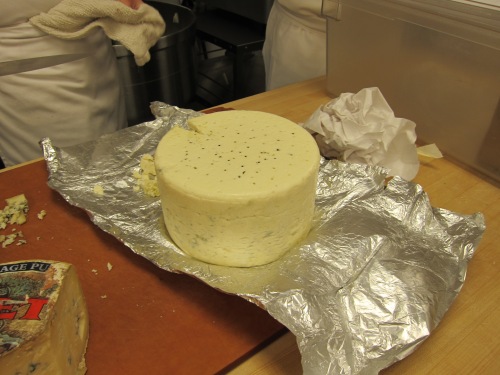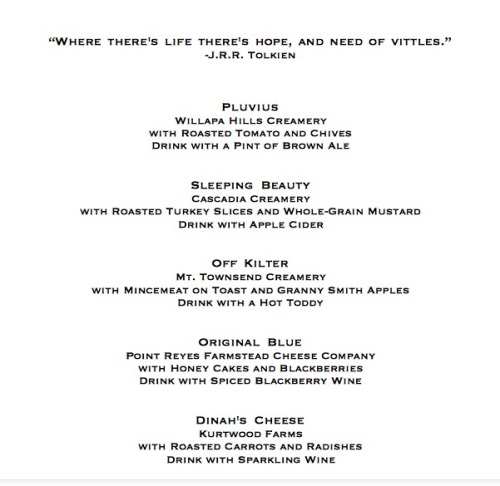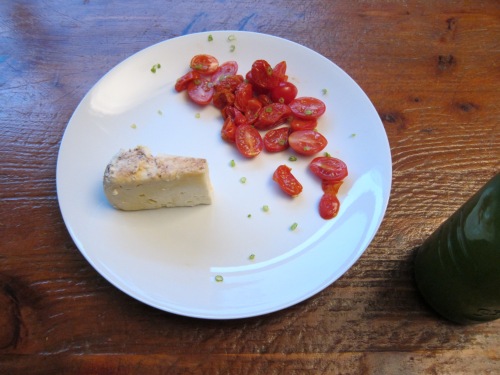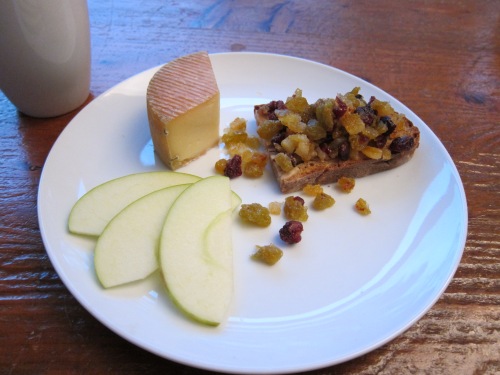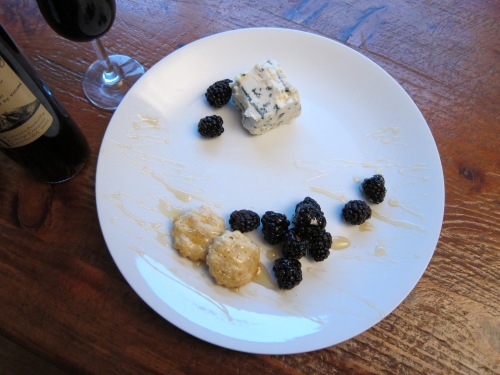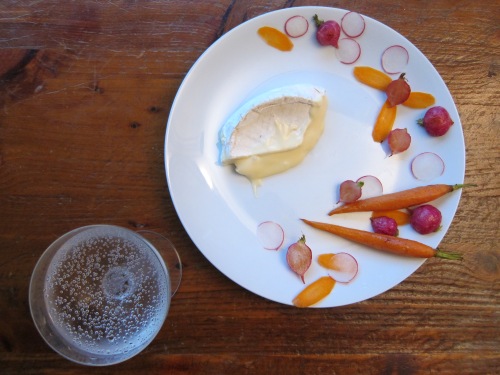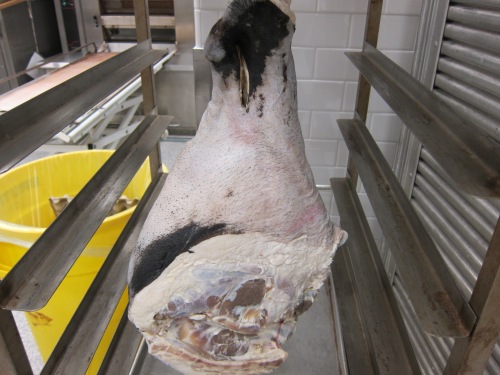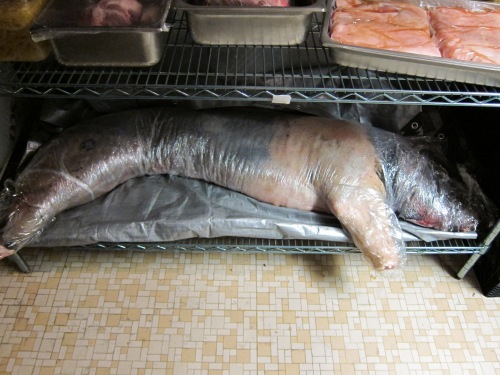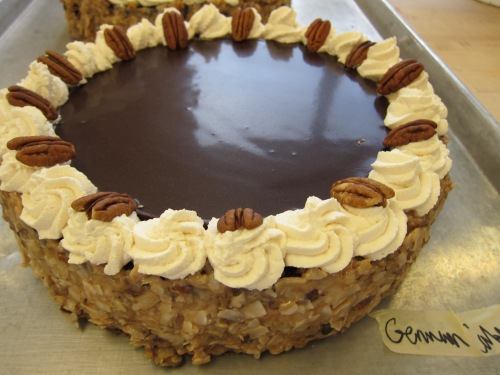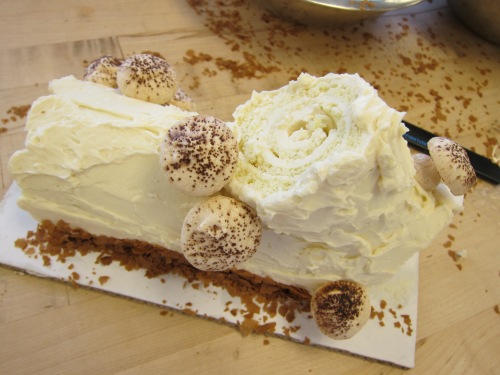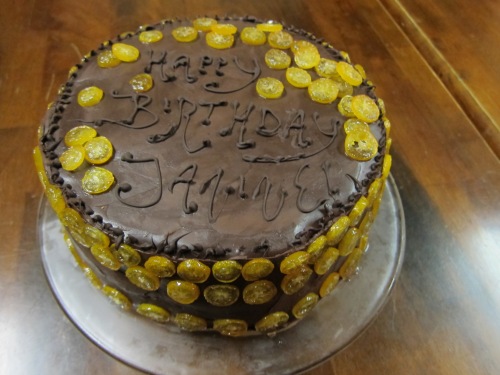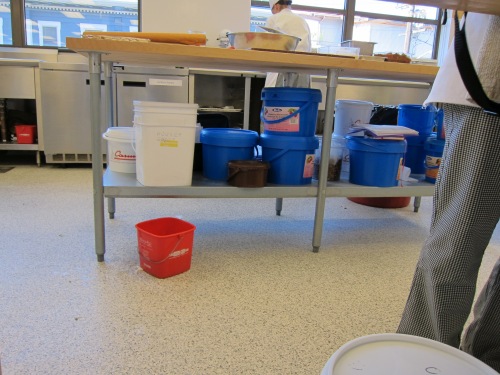
I love Thanksgiving. I am aware of the negative history associated with it, but the holiday as it stands now is my favorite. I love that it is all about food. I love that there is no gift giving involved, besides sharing food with family, friends, and everyone else who appears in my vicinity within a month or two of the holiday. I love finding new recipes to make for Thanksgiving, and the delight on the faces of my Thanksgiving regulars when they see our (relatively new) classics on the table, and spoon heaping piles onto their plates before cascading the food mountains with Niles of gravy. My father passed the Thanksgiving turkey baton to me this year as well. Though I had roasted chickens before, I searched out all turkey-related advice I could find. My father suggested rosemary and garlic in the cavity, and plenty of butter on the outside. Bon Appétit detailed a delicate glaze of mirin and soy sauce that I inelegantly poured over the top of the turkey, creating a good flavor, but some unsightly burned bits on the skin. My culinary teacher recommended a lemon in the cavity to increase moistness in the meat and add some subtle flavoring. After learning how to de-bone a turkey from a family friend, so that it could be grilled for his Thanksgiving, I received my final piece of advice. I roasted my turkeys breast side down so that the juices would run down and keep the white meat moist, instead of being subjected to the most intense heat. This way, they needed no basting and still turned out golden brown. After all, few people can really tell which way is the right way up, especially when a bird is surrounded by all sorts of delicious nibbles.

Though I cannot say Thanksgiving went off without a hitch, and it certainly would not have been as delicious or beautiful without our lovely, practical, co-chef, it was successful. Over years of producing elaborate menus for large groups of people I have learned a few tips to make them run, if not smoothly, at least pothole free.
I always make sure to have every recipe I plan to use in one place, including adjustments for serving size or other changes I made. This is helpful both for myself so I do not have to run around looking for what I need and in case I delegate a certain dish to someone else. They can follow the recipe without my worrying much about it turning out wrong.
I also like to run through the cooking process for each dish, making sure I will have enough oven, stove, and fridge space for each dish at the right time. Anything I can make ahead I do. In the case of Thanksgiving, this means I have a binder with each recipe, cooking schedule, shopping list, and other notes I need up to the serving point of each dish.
The thing I have the most trouble with is the menu itself. I tend to make too much food. I do not make too much of each dish, but I make more dishes than are necessary. Instead of browsing Facebook I browse Food & Wine, and find recipe after recipe I want to try. And I want to try them now. The wisdom of having a few well-matched recipes prepared perfectly as opposed to a cornucopia of commonplace cooking is apparent, and much harder than it sounds. My only advice, the same that rarely succeeds on myself, is to remember that there will be more Thanksgivings and more opportunities to make all the wonderful dishes in your recipe files. Unless, of course, the world ends this winter. My only sorrow then will be that my Christmas cookies were never finished.

Cocktail Bar
I cannot give you Thanksgiving leftovers or Christmas cookie assortments in person, but my urge to share food does not slow until January or so. I will have to share food with you through the intricately webbed paths of the Internet, via recipe. Probably the two most important dishes at Thanksgiving are stuffing and gravy. Though my versions are not perfect, they are tasty and satisfying for anyone from an enthusiastic teenage eater to a health conscious butter-phobe (not that I skimp on the butter on Thanksgiving). I also believe that both stuffing and gravy are not eaten enough during the rest of the year. They are perfect accompaniments to roast chicken, fall vegetables, or really anything. Stuffing uses up any old bread staling up on the counter, and stock for gravy can be made any time from animal bones and frozen for ages.
The Fool
Stuffing
Makes one 9×13 baking pan
Ingredients:
Two medium loaves bread
One large yellow onion
Three celery ribs
Butter or oil (for richer stuffing use up to one stick butter)
Two tablespoons (about) assorted minced herbs like rosemary, thyme, sage, etc.
Two cloves garlic, minced (optional)
Two cups stock (about)
Two eggs
Tear bread into crouton-size chunks. Either put in a bowl or bag to dry for several days f spread in a single layer on a baking sheet and dry in a 350˚F oven for about fifteen minutes. Make sure the bread is dry all over but not burned.
Roughly chop the onion and celery. Sauté the onion, celery, and garlic in butter or oil until softened. Stir in herbs and season with salt and pepper. Cool slightly and mix in with the bread chunks in a large bowl. Add the stock slowly and mix, until all the bread chunks are softened and squishy, but there is little stock not absorbed. You may not need two cups of stock, and may need more. Go by the feel of the softened bread instead of the measurements. Mix in the eggs.
Spread the stuffing in the baking pan and cover with tin foil. It can be refrigerated at this point for a day. Bake, covered, at 350˚F for 40 minutes, and then remove the foil. Continue baking uncovered for 15 to 25 minutes, until the top is crusty and the stuffing is warm all the way through. The USDA recommends baking stuffing made with poultry stock to an internal temperature of 165˚F, and these baking times should allow it to reach that temperature. Serve warm with gravy.
Notes:
Using flavored bread such as roasted garlic or rosemary adds depth of flavor.
Bread ripped into chunks allows the stock and flavors to be more fully absorbed, but cutting the bread into chunks is also acceptable.
The stuffing can be baked until the point when the foil is removed, and then refrigerated for a day. The next day it can be baked, uncovered, until it is warmed all the way through.
Stock for gravy:
The standard ratio for making stock is 8 pounds bones:1 1/2 gallons water:1 pound mirepoix (a mix of 50% onion, 25% carrot, and 25% celery). The bones are browned in a 425˚F oven for about 90 minutes, until they are dark on every side. Be sure to turn the bones occasionally. The bones, cold water, and mirepoix are then placed in a stockpot along with a teaspoon or so of peppercorns and about a tablespoon of coarse kosher salt. The stock is then boiled at a low temperature for 2 ½ to three hours, cooled, and the solids strained out. Be sure to skim the white foam that appears off the top of the stock. If too much is left the stock will be bitter. The finished stock can be refrigerated for about three days and frozen a year or so. I like to freeze my stock flat in Ziploc bags in two cup quantities. The bags are easily stacked and quickly thawed. Just make sure each bag is labeled with the date and type of stock.
Besides this basic recipe there are many other ways and tips for making stock:
Be sure to use cold water, and even a few ice cubes, when making stock. This lets the flavor be extracted more slowly and prevents bitter impurities from taking over the flavor.
The bones do not need to be browned, but the stock will be a lighter color and slightly less flavorful.
I also keep a bag of frozen vegetable scraps and will put these in stock. Parsley stems, leek ends, mushrooms, parsnips, and a few other vegetable bits add more flavor to stock.
For clearer stock, the strained stock can be run through a strainer covered with cheesecloth to remove more bits.
Beef, chicken, and turkey bones all make excellent brown stock. If making stock with fish or shellfish scraps, do not brown them.
The technique for vegetable stock is basically the same, except browning the vegetables is optional and should be done in a dry pan or pot, not the oven. I find mushrooms, especially a few ounces of dried porcini, add the most flavor to vegetable stock. Ginger, soy sauce, and lemongrass can be added to vegetable stock for a different flavor profile.
For gravy:
Gravy can be thickened with either roux or cornstarch. Make sure the stock you are using for gravy is at least at room temperature before thickening.
Roux is a cooked mixture of flour and fat, usually butter. Melt the butter and then whisk in the flour. It will turn into a paste. The longer a roux is cooked the darker it will become. The darker a roux gets the more flavor it has and the less thickening power it has. For gravy I tend to use a lighter roux because the stock should have plenty of flavor. For roux I use the ratio of 1 ounce (2 tablespoons) butter:1 ounce (2 tablespoons) flour. I thicken each cup of stock with one ounce of roux. After the stock is added to the roux, or vice-versa, whisk until the gravy begins to thicken. At this point it should be seasoned with salt or pepper and drippings from a chicken or turkey, herbs, and any other flavorings can be added. Roux can also be made, frozen, and reheated.
For gravy made with cornstarch I would generally add more flavorings to the finished gravy. A slurry (a mixture of liquid and cornstarch) must be made before the cornstarch is added to the stock because, unlike roux, it does not dissolve evenly in liquid and can be lumpy. For every two cups of stock I would use about one tablespoon of cornstarch whisked in and dissolved in about ¼ cup stock. The slurry is then whisked into the stock and whisked until thickened. Again, at this point, season with salt and pepper, and add any other flavorings.
